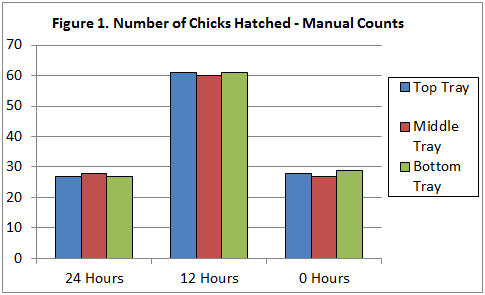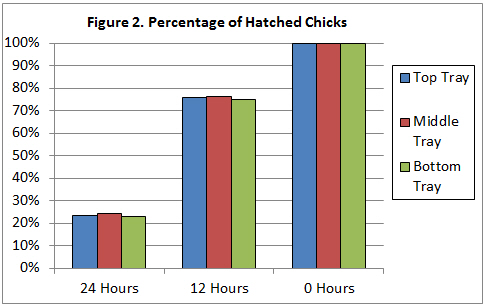



Practical Monitoring, Interpretation and Control of the Hatch Window
Advice on optimum hatchery management - particularly the monitoring and control of the hatch-window - from Angel Salazar of ChickMaster.Introduction
The concept of monitoring and exerting as much control as possible on duration of the hatch window has taken much more relevance and practical value over the past several years in modern poultry hatcheries. Nowadays, many of the new generation hatchery supervisors heavily rely on computer-generated graphs to monitor and control not only the hatch window but all the other important operational parameters contributing to optimal ambient conditions in setter, hatcher and chick rooms.
Definition
Is the time period during which the great majority of chicks inside a given hatcher cabinet would have actually hatched. Whatever the definition, our focus should be to establish a routine study of the behaviour and chronology of the hatch window. This practice can then be defined as a standard method by means of which one is able to determine the progression of the number of chicks that are hatching in a given time period once an egg batch has been transferred from the setter into the hatcher cabinet.
Discussion
At this point, a pertinent question would be… Why is it important to monitor the duration and behaviour of the hatch window? Next, let us try to offer an explanation. At housing, it is common for chick bodyweight differences to be higher than the variability observed in newly hatched chicks.
The bodyweight of chicks at housing/placement is affected by their hatch weight, the hatcher environment, the amount of time they spent in the hatcher, in the chick room and inside delivery vehicles during transport. If early hatching chicks have to wait inside the hatcher cabinet for a long time period, they will dehydrate and lose weight.
In 2005, Careghi et al. determined this loss could be in excess of eight per cent of initial hatch weight in just 24 hours. Thus, a prolonged hatch window results in chicks having to wait unnecessarily in the hatcher cabinet for chick harvest. This in turn, increases the variation in chick size. Ideally, we must not exceed a 2.0 to 2.5 per cent loss in chick bodyweight from hatch to through farm delivery.
The length of the hatch spread/window depends on two key components:
- Right from the start of the incubation process, most of the embryos making up an egg set/batch should be at a similar stage in their development. This is mostly related to the composition of the egg batches – breeder flock age and storage time. Perhaps most importantly, we should assess our ability to implement a quick and uniform pre-warming period to produce a rise in internal egg temperature and reactivate cell division.
- After the egg mass is introduced and conditioned inside the setter cabinet, the machine must be fully capable to cause the embryos to develop at a similar and uniform rate.
In order to exert a positive influence on the duration and behaviour of the hatch window, we should aim at shortening its duration and to maximise its hatch peak. This minimises the percentage of chicks that hatch too early and the percentage of chicks hatching late. In other words, we must strive to attain graphs, curves describing narrow bases, a high degree of symmetry and higher hatch peaks per unit time (see Figure 1).

Next, let us look at a list of key factors known to impact the duration and behaviour of the hatch window.
- The duration and timeliness of the hatch window is primarily influenced by:
- Setter design, e.g. operator's ability to operate modular or zone controlled setter cabinets.
- The relative positioning of the interior fans, cooling coils and heating elements with respect to the embryo mass.
- The uniformity and velocity of the internal air flow throughout the incubating embryo mass inside the setter cabinet.
- The factors listed above determine the uniformity of egg shell temperatures which allow a uniform and synchronised rate of embryo development once the fertile blastoderms reinitiate cell division after pre-warming takes place.
- Finally, our goal is to attain hatch windows of short duration - less than 24 hours - such as the ones described by graphs/curves exhibiting a narrow base, a high degree of symmetry and high peaks for hatching activity.
- Other factors influencing the hatch window are:
- Length and temperature of egg storage.
- Breed and age of parent flock.
- The hatching egg-set mix composition inside the setter cabinet.
- In this regard, on a per module basis inside the setter, one should try to make up hatching egg batches that differ by a maximum of five to six weeks in breeder flock age and no longer than four days in storage time.
General Strategy for Implementing a Routine Inspection Protocol – Hatch Window
For those operators lacking computer tools that facilitate routine, timely inspection of relative humidity or wet bulb graphs/curves on a screen for any given hatcher unit, a maximum of three visual inspections in a given hatcher is all that can be implemented in the context of a large poultry hatchery.
The following general protocol applies to a 19-day transfer – after 456 hours from set through transfer. Total incubation time from egg setting to chick pull of about 502 to 504 hours is also being considered.

- Select (three) setters egg trays for monitoring the behaviour and progress of your hatch window. One tray from the top of the setter trolley or fixed racks. A second egg tray should be drawn from a middle position and, a third egg tray from a bottom location.
- Label and identify the chosen setter egg trays on their respective hatcher baskets. Stack the (three) hatcher baskets on top of one another right at the top of a single tier/column of hatcher baskets.
- At transfer time – 456 hours of incubation time, one should only be able to detect anywhere from one to two per cent pipped eggs and no hatched chicks.
- The first visual inspection should take place 12 hours after the eggs were transferred into the hatcher baskets. That is 456+12 = 468 hours of incubation time – at 19.5 days into the incubation process. At this point in time, we should be able to detect a maximum of one to three per cent hatched chicks.
- About 24 hours before chick pull. Or, 480 hours – 20 days into the incubation process, we should be able to detect a maximum close to 20 to 25 per cent of the total chicks to be counted at pull time, hatched or in the process of hatching.
- At 12 hours before pull time. Or 492 hours – 20.5 days into the incubation process, 12 hours before chick harvest, we should be able to detect a minimum in the range of 75 to 80 per cent hatched chicks (see Figure 2).
- Let us remember these figures or number of chicks hatched need to be computed as percentages of the total number of chicks collected at the end of the process, not as percentages of eggs transferred.
- At pull time, after 500 to 504 hours of total incubation time, we should be able to detect that the great majority of chicks are dry, comfortable, quiet, relaxed and, ready to be collected from the hatcher baskets (see image above).

Now, as we all know, in the context of a large commercial poultry hatchery, one dealing with 10 to 15 different breeder flocks, it would be impossible to carry out the above inspection procedure on a routine basis on all flocks.
This is where having a specific software programme allows the modern hatchery manager quick, real-time, routine monitoring of the hatch window in several hatchers almost simultaneously. This is not to say that proper study and interpretation of graphs on a computer screen do not require time and effort on your part but it does greatly simplifies this very important task.
Conclusions
The main objective when managing and controlling ambient/operational conditions inside setter/hatcher cabinets and room conditions must be to achieve timely hatch window of short duration consistently. Machine design, uniformity and consistency of machine air flow, of temperature and relative humidity are key, contributing factors that cannot be overlooked.
Computer-generated graphs are essential tools that provide the analytical means by which one is able to study and interpret the behaviour of hatch window in several hatchers for later adjustment and fine-tuning of setter/hatcher profiles, setter/hatcher room conditions and operational configuration and constraints of our incubation systems.
Computer-aided, routine investigation of the hatch window has become in many modern day hatcheries an additional means to double check and make sure we are using the right setter/hatcher profiles, properly maintaining incubation systems and ventilation equipment and, exerting accurate and timely control of ambient conditions in setter/hatcher rooms.
A hatch window attaining a high hatch peak - one that concentrates the highest possible percentage of hatched chicks in a given time-frame - minimises the potential dehydration risk for the relative small number of chicks that tend to hatch first.
To visit the ChickMaster web site, click here.
December 2013











